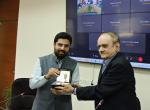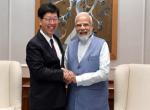Swami Vivekananda once visited a great sage of our country, a very holy man and wrote: “We talked about our revered book- the Vedas, of your Bible, of the Koran, and of the revered books in general. At the close of our talk, this great sage asked me to go to the table and take-up the book; it was a book, which, among other things, contained a forecast of the rainfall during the year. The sage said, Read them. And I read out the quantity of rain that was to fall. He said, now take the book and squeeze it. I did so and he said, why my boy, not a drop of water comes out. Until the water comes out, it is all book, book.”
This is also the story of disaster management in India. We have a National Disaster Management Act, a National Disaster Management Authority with the Prime Minister of India as its Chief, a country wide disaster management apparatus, an impressive array of knowledge institutions, a full fledged National Institute of Disaster Management and an over stocked library of Guidelines, Plans, SOP’s and Office orders. It is time we squeeze them all to count the drops! We have definitely progressed but we have a very long way to go.
By the very nature of the challenge, the road to disaster management has always been under construction and will remain so in the future as well. It has long been realized that the road begins from the territory of policy formulation, but the results will begin to trickle in only the day we come out of the comfort-zone of the business as usual and bridge the gap between our scientific and operating tempers and between the plan and its implementation. In our straight –jacket style of functioning, we get easily swayed when we see a logical, demand based approach to project identification, a scholarly written feasibility report tuned to environmental sensitivities, and a convincing environmental impact assessment. An exclusive chapter on Integration of disaster risk reduction with the project planning makes us feel that now is the time to take a break and hope for the things to happen on their own, as we had planned. Have we ever thought whether it is the right road that would lead us to the freedom from disasters?
Only one road can lead us to freedom from disasters and that is the road passing through the culture of safety to be travelled in the vehicle of non-violence with a deep sense of commitment to posterity. I have lost no chance to express myself by repeating Antoine de Saint Exupéry‘s words: “If you want to build a ship, don’t drum up men to collect wood and don’t assign them tasks and work, but rather teach them to long for the endless immensity of the sea.”
The real world of disasters is far more complex than we can singly or collectively imagine. In the real world, we can be only as successful as our ability to foresee multiple scenarios of hazards, vulnerability and risk. For decades, we have been in the business of making hazard maps and printing atlases. Let us squeeze and stir all our hazard maps and atlases, and count the drops. Sorry, we will have to wait until someone more serious and scientific places the first, validated and user-friendly hazard map into our hands. And imagine, if we can’t reliably anticipate the hazards before they strike, how can we ever prevent them from happening?
We are a democratic country and in order to appear democratic, we are perpetually engaged in discussion and planning, that leaves us without much time to spare for implementation of plans. According to Netaji Subhas Chandra Bose, “no real change in the history has ever been achieved by discussion.” But his words did not suit our way of life. Discussion per se is not bad, but when it comes to managing disasters, we have seen our plans getting bogged down in the quicksand of endless discussion and become stale on its way to the printing press. It is said that the devil is in the detail and yet we prefer to ignore details and instead face the wrath of the devil. On the other extreme are our people who would not move an inch beyond discussion because of the paucity of data or absence of consensus. ” Reality is, after all, too big for our frail understanding to fully comprehend. Nevertheless, we have to build our life on the theory which contains maximum truth. We cannot sit still because we cannot, or do not know the absolute truth,”said Netaji Subhas Chandra Bose. “The finest of the plans are always ruined by the littleness of those who ought to carry them out, for the Emperors can actually do nothing”, said Bertolt Brecht.1
The use of clever or dishonest methods (chicanery) and sugar-coated populist approaches have hurt us a great deal. Non transparent approaches in the investigation and knee-jerk reporting often sully the disaster case records and bury the truth deeper. We were taught in the classroom to walk slowly when in a hurry. But in the race for supremacy in reporting, we fancy reporting as we walk and document as we talk. As Richard Bach has said, “The world is your exercise book, the pages on which you do your sums. It is not reality, though you may express reality there if you wish. You are also free to write lies, or nonsense, or to tear the pages.”2 But by not being honest, are we not robbing the future generations of the awe inspiring grandeur of nature’s exposition? By ignoring proof, logic and science, are we not ignoring our own future? Are we not increasingly getting identified as the generation of editors rather than of authorship?
From the Italian proverb “Alexander never did what he said and Caesar never said what he did”, we infer that disaster managers are generally seen to play Alexander’s role for the wrong reason. This is because of the Hobson’s choice managers face in dealing with disaster scenarios as they unfold, bearing little or no resemblance to those about which they had spoken. We have to create systems in which our actions speak louder than our words and we will feel free to act as Caesar did. Only when we will have the courage and humility to confess that our plans were useless scraps of paper as testified by the recent tragedies, that we will justifiably get license to plan. Einstein once said, “Few people are capable of expressing with equanimity opinions which differ from the prejudices of their social environment. Most people are ever incapable of forming such opinions.” He further adds that, “we cannot solve the problems we have created with the same thinking that created them”. And, according to John Maynard Keynes, “Difficulty lies not in the new ideas, but in escaping the old ones.”
We have long been working with an ill-defined disaster management strategy conceived in a comfort zone, reducing one of the most challenging tasks to a hectic exercise in relief and response. With the advent of the National Disaster Management Act of 2005 came the hope that the world around us would begin to change from then onwards. We had hoped to see more of prevention and mitigation, more of the culture of scientific scrutiny and technological innovation, and more of an action than speeches. We seek development, but what value is that development which fuel disasters and takes us back to the zero-sum game? It is no choice, if we are asked to choose our day between 12 hours of pain followed by 12 hours of pleasure, or for 12 hours of pleasure followed with 12 hours of pain!
“There was an old owl, who lived in an Oak. The more he heard, the less he spoke. The less he spoke, more he heard. O, if men were like that wise old bird.”3 The time has come when speeches can wait and the endless engagement with the design of wings can end. All we need is a vision, a sense of direction and a will to succeed. “If a man does not know to what port he is steering, no wind is favourable to him.” 4 Let us recall Ray Bradbury, who said that, “You’ve got to jump off cliffs all the time and build your wings on your way down.”
Please listen, the last of the sparrow or sterling, which wants to fly to freedom from disasters is watching our movies! And as Martin Luther King, Jr, has said, “Take the first step in faith. You don't have to see the whole staircase, just take the first step.”
(The author is a Disaster Management Expert based in Delhi)
Endnotes
- Bertolt Brecht in Mother Courage, 1939.
- Richard Bach, Illusions: The Adventures of a Reluctant Messiah
- Cited from Punch.
- Seneca
Published Date: 28th August 2014, Image source: http://www.sristi.org
(Disclaimer: The views and opinions expressed in this article are those of the author and do not necessarily reflect the official policy or position of the Vivekananda International Foundation)








Post new comment